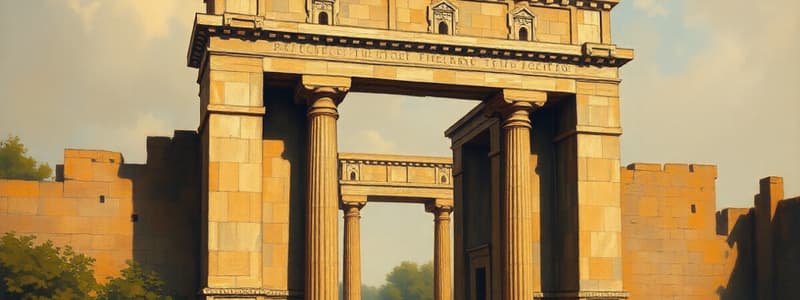Podcast
Questions and Answers
What materials were initially used in the construction of buildings in Mesopotamia?
What materials were initially used in the construction of buildings in Mesopotamia?
Mud, reeds, and palm trees were the initial raw materials used for building.
What was the mainstay of the Mesopotamian economy?
What was the mainstay of the Mesopotamian economy?
Agriculture was the mainstay of the Mesopotamian economy.
Describe the social hierarchy in Mesopotamian society.
Describe the social hierarchy in Mesopotamian society.
The social hierarchy included the king at the top, followed by priests, officers, scribes, merchants, landowners, craftsmen, and then slaves and peasants at the bottom.
What role did the king play in Mesopotamian society?
What role did the king play in Mesopotamian society?
How did Mesopotamians ensure a steady water supply for their agriculture?
How did Mesopotamians ensure a steady water supply for their agriculture?
What were some of the goods traded by Mesopotamian merchants?
What were some of the goods traded by Mesopotamian merchants?
Why was the army considered important in Mesopotamian society?
Why was the army considered important in Mesopotamian society?
What evidence suggests that there was trade between Mesopotamia and the Indus Valley?
What evidence suggests that there was trade between Mesopotamia and the Indus Valley?
How did the views on kingship evolve in Mesopotamia over time?
How did the views on kingship evolve in Mesopotamia over time?
What innovations in agriculture aided the growth of farming in Mesopotamia?
What innovations in agriculture aided the growth of farming in Mesopotamia?
What does the term 'Mesopotamia' mean?
What does the term 'Mesopotamia' mean?
Which civilizations ruled Mesopotamia in succession?
Which civilizations ruled Mesopotamia in succession?
What significant architectural structure was prominent in each Mesopotamian city?
What significant architectural structure was prominent in each Mesopotamian city?
What were city-states in Mesopotamia?
What were city-states in Mesopotamia?
What challenges did Mesopotamian city-states face?
What challenges did Mesopotamian city-states face?
When did the Mesopotamian civilization flourish?
When did the Mesopotamian civilization flourish?
Which gate was built around 575 BCE in Babylon, and what was it known for?
Which gate was built around 575 BCE in Babylon, and what was it known for?
What geographic feature defines the southernmost part of Mesopotamia?
What geographic feature defines the southernmost part of Mesopotamia?
Flashcards are hidden until you start studying
Study Notes
Geographical Context
- Tigris and Euphrates rivers originate in Turkey, flowing through Syria and Iraq into the Persian Gulf.
- Mesopotamia, meaning ‘the land between two rivers’, is located between these rivers, bordered by the Arabian Desert and Iranian mountains.
Mesopotamian Civilization Overview
- One of the earliest civilizations, Mesopotamian civilization emerged around 3500 BCE and thrived until approximately 500 BCE.
- Regions included Sumer (southern), Babylonia (northern), Akkad (central), and Assyria (northeast).
- Sumerians initially ruled, later succeeded by Babylonians and Assyrians who adopted and integrated Mesopotamian culture.
City-States Structure
- Mesopotamian cities were city-states, each functioning as an independent political entity.
- Major city-states included Babylon, Uruk, Eridu, Lagash, and Ur.
- Each city had a ziggurat, a temple tower built on artificial hills, serving as religious and administrative centers.
Urban Planning and Architecture
- Cities like Ur featured a sacred walled city and an outer town, with narrow, unruly streets.
- Houses were often single-room with central courtyards, built from locally available materials like mud, reeds, and palm trees.
- Architectural advancements included the introduction of fired bricks.
Social Hierarchy
- Society was class-divided: Kings were seen as divine representatives, followed by priests, officers, scribes, merchants, and craftsmen.
- Slaves and peasants constituted the lowest social class, often victims of warfare.
Kingship and Governance
- Initially, priest kings had limited power, but over time kings gained a divine status.
- Kings were responsible for city defense, infrastructure, irrigation, justice administration, and care for the poor.
Economic Foundation
- Agriculture was central, with crops like wheat, barley, pulses, and vegetables.
- Advanced irrigation methods were developed, utilizing canals for year-round water supply.
Trade and Commerce
- Extensive trade networks existed, with traders traveling to the Mediterranean and exchanging goods like grains and textiles for metals and luxury items.
- Mesopotamian seals discovered in the Indus Valley evidence significant trade connections with other civilizations.
Studying That Suits You
Use AI to generate personalized quizzes and flashcards to suit your learning preferences.



